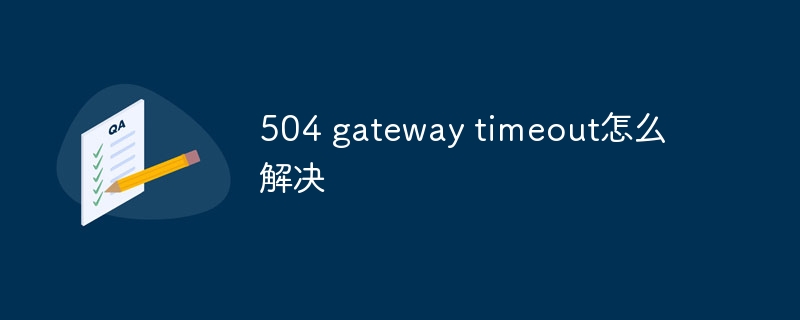
504 gateway timeout solutions: 1. Check the server load; 2. Optimize the query and code; 3. Increase the timeout limit; 4. Check the proxy server; 5. Check the network connection; 6. Use load balancing; 7. Monitoring and logging; 8. Troubleshooting; 9. Add cache; 10. Analyze requests. Resolving this error often requires a combination of factors, including server performance, network connectivity, proxy server configuration, and application optimization.

"504GatewayTimeout" is a common HTTP status code that usually indicates that when the client (usually a browser) makes a request to the server, the server is waiting for another request. A server timed out when responding. This error is usually caused by the following reasons:
1. The server responds slowly: The server is processing the request, but the processing time is too long and exceeds the server's timeout limit. This may be caused by overloaded servers, complex database queries, processing large files, etc.
2. Proxy server problem: In some cases, the request may be forwarded to the backend server through the proxy server. If there is a problem with the proxy server or the configuration is incorrect, it will also cause the "504GatewayTimeout" error.
3. Network problems: There may be problems with the network connected to the server, such as network interruption, packet loss, insufficient bandwidth, etc., which will cause the request to time out.
4. Back-end service problems: Back-end servers (such as application servers and database servers) may have problems and cannot respond to requests in a timely manner.
5. Improper server configuration: The server may be improperly configured, causing the timeout limit to be too low and needs to be adjusted.
To solve the "504GatewayTimeout" error, you can take some of the following methods:
1. Check the server load: Make sure the server is not overloaded. Use server monitoring tools to view the resource utilization of the server. If the server resources (CPU, memory, disk) are exhausted, it may be necessary to upgrade the server or optimize the code.
2. Optimize queries and code: If the request requires interaction with the database, ensure that the database query and operation are efficient. Optimize query statements and use indexes to reduce response time. Also, check your application code to make sure there are no long-running operations.
3. Increase the timeout limit: If the server's timeout limit is set too low, consider increasing it. This can be done in the server configuration or proxy server configuration, depending on your architecture.
4. Check the proxy server: If you use a proxy server (such as Nginx, Apache, etc.), make sure they are configured correctly and do not cause problems. Check the proxy server logs to see if a specific request is causing the problem.
5. Check the network connection: Make sure there is no problem with the network connection between the server and the client. Check firewall settings, router configuration, and network bandwidth to see if they are sufficient.
6. Use load balancing: If your application uses multiple servers for load balancing, you can consider distributing requests to different servers to reduce the burden on each server and improve system availability.
7. Monitoring and logging: Set up a monitoring and logging system to monitor server performance and requests in real time. This can help you quickly identify problems and take steps to resolve them.
8. Troubleshooting: Carefully check the server and application logs for any error messages or warnings related to request timeouts. This may provide more clues about the problem.
9. Increase caching: Using appropriate caching strategies can reduce the number of requests to the back-end server, thereby reducing the possibility of timeout errors.
10. Analyze requests: Check the specific requests that trigger the "504GatewayTimeout" error to understand their characteristics, possible patterns, and which requests are prone to timeouts.
In short, solving the "504GatewayTimeout" error usually requires a comprehensive consideration of multiple factors, including server performance, network connection, proxy server configuration and application optimization. Taking appropriate action based on the situation can help you reduce or eliminate this error and improve the usability and performance of your website or application.
The above is the detailed content of How to solve 504 gateway timeout. For more information, please follow other related articles on the PHP Chinese website!
 How to solve 504 gateway timeout
How to solve 504 gateway timeout
 How to configure default gateway
How to configure default gateway
 How to restore friends after being blocked on TikTok
How to restore friends after being blocked on TikTok
 What should I do if the copy shortcut key doesn't work?
What should I do if the copy shortcut key doesn't work?
 How to solve the problem of dns server not responding
How to solve the problem of dns server not responding
 Database er diagram
Database er diagram
 The function of span tag
The function of span tag
 Five major components of a von Neumann computer
Five major components of a von Neumann computer




